 Spider-Woman #16 — Writer: Dennis Hopeless; Art: Veronica Fish; Colors: Rachelle Rosenberg
Spider-Woman #16 — Writer: Dennis Hopeless; Art: Veronica Fish; Colors: Rachelle Rosenberg
Hulk #3 — Writer: Mariko Tamaki; Art: Nico Leon; Colors: Matt Milla
Moon Girl and Devil Dinosaur #16 — Writers: Brandon Montclare and Amy Reeder; Art: Natacha Bustos; Colors: Tamra Bonvillain
Elektra #1 — Writer: Matt Owens; Art: Joann Cabal; Colors: Antomio Fabela and Marcio Menyz
 Scarlet Witch #15 — Writer: James Robinson; Art: Vanesa Del Ray; Colors: Jordie Bellaire
Scarlet Witch #15 — Writer: James Robinson; Art: Vanesa Del Ray; Colors: Jordie Bellaire
Spider-Gwen #17 — Writer: Jason Latour; Art: Robbi Rodriguez; Colors: Rico Renzi
Leading with the Marvel women again: a lot of these books aren’t big sellers on the newsstands, but expand their audience through better-than-average sales through the trade collections and other, less-traditional media — and they’re opening up whole new generations and classes of comics readers, so 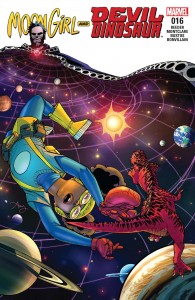 they deserve some attention. They’re also good stories — Spider-Woman ends its latest arc with this week’s issue, and, my God, this whole volume has been a treat from the beginning, from pregnant Jessica vs the Skrulls through new-mom Jessica to, now, an unexpected yet very logical stand-up-and-cheer emotional connection that should make loyal readers very happy. Veronica Fish brings a scruffy, sort-of-indy look to the art that suits a book that’s as smart, scrappy and DIY as its heroine. Hulk has its own usually-sunny heroine in a much darker place, but it’s only halfway through its first storyline so far; amazingly, after three issues Jen’s alter ego has yet
they deserve some attention. They’re also good stories — Spider-Woman ends its latest arc with this week’s issue, and, my God, this whole volume has been a treat from the beginning, from pregnant Jessica vs the Skrulls through new-mom Jessica to, now, an unexpected yet very logical stand-up-and-cheer emotional connection that should make loyal readers very happy. Veronica Fish brings a scruffy, sort-of-indy look to the art that suits a book that’s as smart, scrappy and DIY as its heroine. Hulk has its own usually-sunny heroine in a much darker place, but it’s only halfway through its first storyline so far; amazingly, after three issues Jen’s alter ego has yet 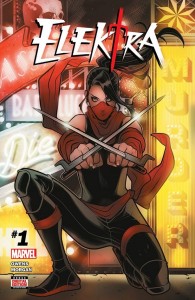 to appear, except on the covers, but her attempts to repress it, and the hints that it’s much more angry and dangerous now, are effective, and you have to admire the creators’ courage in holding back for so long. Moon Girl and Devil Dinosaur gets us back on the sunny/optimistic side, as Devil Dinosaur gets shrunk (and acts like, depending on your perspective, either the world’s ugliest or most adorable puppy), Lunella has a science-vs-magic discussion with Doctor Strange, and a few other guest stars show up to remind us just how critical a part she’s beginning to play in the larger Marvel universe. Montclare, Reeder, Bustos and Bonvillain, who’ve been on this comic from the beginning, are
to appear, except on the covers, but her attempts to repress it, and the hints that it’s much more angry and dangerous now, are effective, and you have to admire the creators’ courage in holding back for so long. Moon Girl and Devil Dinosaur gets us back on the sunny/optimistic side, as Devil Dinosaur gets shrunk (and acts like, depending on your perspective, either the world’s ugliest or most adorable puppy), Lunella has a science-vs-magic discussion with Doctor Strange, and a few other guest stars show up to remind us just how critical a part she’s beginning to play in the larger Marvel universe. Montclare, Reeder, Bustos and Bonvillain, who’ve been on this comic from the beginning, are 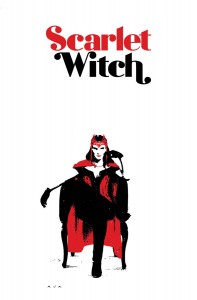 in a groove that’s confident, charming and as comfortable as an old shoe. Elektra, the only first issue here, is also the most traditional — but it’s very stylish, with a casino high-roller setting and sleek fashion-conscious art from Joann Cabal that reminds me of Adam Hughes, and makes even the pedestrian mobster plot and obvious-from-page-three villain worth reading about. Scarlet Witch ends its run on its own terms, with writer Robinson having told a single over-arching story divided into sixteen mostly-stand-alone chapters, drawn by a series of wonderful artists: Vanesa Del Ray, who provided the art for both the
in a groove that’s confident, charming and as comfortable as an old shoe. Elektra, the only first issue here, is also the most traditional — but it’s very stylish, with a casino high-roller setting and sleek fashion-conscious art from Joann Cabal that reminds me of Adam Hughes, and makes even the pedestrian mobster plot and obvious-from-page-three villain worth reading about. Scarlet Witch ends its run on its own terms, with writer Robinson having told a single over-arching story divided into sixteen mostly-stand-alone chapters, drawn by a series of wonderful artists: Vanesa Del Ray, who provided the art for both the  first issue and this last one; Marco Rudy; Steve Dillon, in some of his last work before his untimely death; Annie Wu; Javier Pulido; Marguerite Sauvage; Joelle Jones; and Tula Lotay, all held together by the stunning David Aja covers, which just cry out to be some kind of poster or book or wallpaper or something. That leaves Spider-Gwen, in the middle of a six-part crossover with the Miles Morales Spider-Man, wherein the two teens bond, banter and discover both a mutual respect and a mutual attraction, as they try to rescue Miles’s dimension-hopping father; it’s a faster-moving and more character-driven tale than these events usually are, and all the better for it.
first issue and this last one; Marco Rudy; Steve Dillon, in some of his last work before his untimely death; Annie Wu; Javier Pulido; Marguerite Sauvage; Joelle Jones; and Tula Lotay, all held together by the stunning David Aja covers, which just cry out to be some kind of poster or book or wallpaper or something. That leaves Spider-Gwen, in the middle of a six-part crossover with the Miles Morales Spider-Man, wherein the two teens bond, banter and discover both a mutual respect and a mutual attraction, as they try to rescue Miles’s dimension-hopping father; it’s a faster-moving and more character-driven tale than these events usually are, and all the better for it.
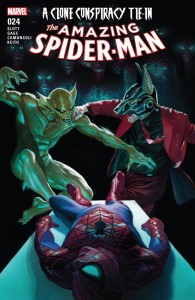 Amazing Spider-Man #24 — Writer: Dan Slott and Christos Gage; Pencils: Giuseppe Camuncoli; Inks: Cam Smith; Colors: Jason Keith
Amazing Spider-Man #24 — Writer: Dan Slott and Christos Gage; Pencils: Giuseppe Camuncoli; Inks: Cam Smith; Colors: Jason Keith
Black Panther #11 — Writer: Ta-Nehisi Coates; Layouts: Chris Sprouse; Finishes: Goran Sudzuka, Walden Wong, Karl Story and Roberto Poggi; Colors: Laura Martin with Diverse Hands
Inhumans vs X-Men #5 (of 6) — Writers: Jeff Lemire and Charles Soule; Art: Javier Garron; Colors: David Curiel
Thunderbolts #10 — (Prologue): Writer: Kurt Busiek; Pencils: Mark Bagley; Inks: Scott Hanna; Colors: Matt Yackey; (Main 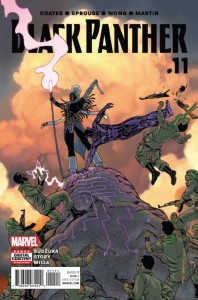 Story): Writer: Jim Zub; Art: Jon Malin; Colors: Matt Yackey
Story): Writer: Jim Zub; Art: Jon Malin; Colors: Matt Yackey
Amazing Spider-Man is a coda to the “Clone Conspiracy” story, with only one or two panels on Peter Parker and the rest on his long-thought-dead clone, Ben Reilly, following that character’s actions at the end of the crossover event and setting him up for his own series in a few months. How you feel about that depends on whether you care about Ben Reilly, but it’s by the established Spidey creative team, so regular readers should be fine with it. Black Panther hits the climax of its year-long first arc, and while there’s a lot going on (Revolution in Wakanda! The dead return to defend their homeland!), it’s curiously subdued; 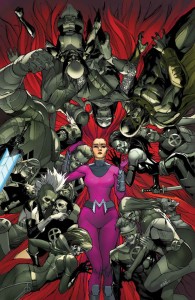 that’s partly because of the many hands involved in the art, which defuses its impact, and partly because Coates, a nonfiction writer by trade, still needs to figure out how to translate his smart ideas and high-end political themes into consistently breathing, lively characters. It’s a noble effort, though, and seeing what he does with a revived and reorganized Wakanda will bring me back for the conclusion next issue, and for the next arc too. Inhumans vs X-Men nears the end of its run, also: the good news is that it’s been delivered on time and without any creative hiccups, treated the characters on both sides with respect for their motivations and strategic smarts, and given us about the story we expected; the bad news is that it’s given us only about what we expected, with no surprises — at least, with one installment to go. Thunderbolts offers a special 20th-
that’s partly because of the many hands involved in the art, which defuses its impact, and partly because Coates, a nonfiction writer by trade, still needs to figure out how to translate his smart ideas and high-end political themes into consistently breathing, lively characters. It’s a noble effort, though, and seeing what he does with a revived and reorganized Wakanda will bring me back for the conclusion next issue, and for the next arc too. Inhumans vs X-Men nears the end of its run, also: the good news is that it’s been delivered on time and without any creative hiccups, treated the characters on both sides with respect for their motivations and strategic smarts, and given us about the story we expected; the bad news is that it’s given us only about what we expected, with no surprises — at least, with one installment to go. Thunderbolts offers a special 20th- anniversary issue, notable because the intro ten-page story is by the book’s original creators, Kurt Busiek and Mark Bagley, and features the return of a long-gone team member: not a bad anniversary present. The main story reintroduces some team members, too, and seems to finally be starting to resolve the Winter Soldier/Kobik stuff (which, let’s face it, hasn’t exactly been compelling), with a decent last-page development, and hints that this will all dovetail into the big Hydra-Cap Secret Empire crossover in a month or two, making it useful for readers trying to keep track of all the players in that event.
anniversary issue, notable because the intro ten-page story is by the book’s original creators, Kurt Busiek and Mark Bagley, and features the return of a long-gone team member: not a bad anniversary present. The main story reintroduces some team members, too, and seems to finally be starting to resolve the Winter Soldier/Kobik stuff (which, let’s face it, hasn’t exactly been compelling), with a decent last-page development, and hints that this will all dovetail into the big Hydra-Cap Secret Empire crossover in a month or two, making it useful for readers trying to keep track of all the players in that event.
 Justice League of America #1 — Writer: Steve Orlando; Pencils: Ivan Reis; Inks: Joe Prado, Oclair Albert and Julio Ferreita; Colors: Marcelo Maiolo
Justice League of America #1 — Writer: Steve Orlando; Pencils: Ivan Reis; Inks: Joe Prado, Oclair Albert and Julio Ferreita; Colors: Marcelo Maiolo
Kamandi Challenge #2 (of 12) — Writer: Peter J. Tomasi; Art: Neal Adams; Colors: Hi-Fi
Deathstroke #15 — Writer: Christopher Priest; Pencils: Joe Bennett; Inks: mark Morales; Colors: Jeromy Cox
Action Comics #974 — Writer: Dan Jurgens; 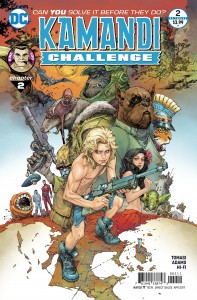 Pencils: Patch Zircher and Stephen Segovia; Inks: Patch Zircher and Art Thibert; Colors: Ulises Arreola
Pencils: Patch Zircher and Stephen Segovia; Inks: Patch Zircher and Art Thibert; Colors: Ulises Arreola
Teen Titans #5 — Writer: Benjamin Percy; Pencils: Khoi Pham; Inkns: Wade von Grawbadger; Colors: Jim Charalampidis
JLA gets started with a statement of purpose (Batman got them together to show the world that flawed humans can still try to be heroes… or something) and then an immediate incursion by the dimension-spanning Extremists; those guys were  serial opponents of the team back in the day (although this seems to be their first encounter in this reality), and have an interesting backstory and powers, although little of that comes through in this first issue — they’re just generic bad guys. The ending promises one of those everybody-underestimates-Batman tales for next issue, though, so that should be fun. Kamandi Challenge wouldn’t normally be on my “buy” list, but it’s drawn by Neal Adams — who, for a guy over 75 years old, has been generating a lot of comic art recently; watching a master like that, someone who’s had more of an impact on comics art than
serial opponents of the team back in the day (although this seems to be their first encounter in this reality), and have an interesting backstory and powers, although little of that comes through in this first issue — they’re just generic bad guys. The ending promises one of those everybody-underestimates-Batman tales for next issue, though, so that should be fun. Kamandi Challenge wouldn’t normally be on my “buy” list, but it’s drawn by Neal Adams — who, for a guy over 75 years old, has been generating a lot of comic art recently; watching a master like that, someone who’s had more of an impact on comics art than  anyone but the actual pioneers, the Kirbys and the Eisners, is always worth your $3.99. Deathstroke continues to be worthwhile because of the Christopher Priest scripting (he’s the only writer besides Slade’s original creator, Marv Wolfman, who’s ever made me care even a little about the character); Priest’s twisty plots and sophisticated time-jumps require an artist capable of clear, dynamic layouts and composition, and Bennett fits that bill. Action is continuing its latest arc about the guy who looks exactly like, and thinks he is, Clark Kent, and it’s crossing over into the regular Superman title, too; DC’s managed to offer intriguing plots and relationships for the Man of Steel ever
anyone but the actual pioneers, the Kirbys and the Eisners, is always worth your $3.99. Deathstroke continues to be worthwhile because of the Christopher Priest scripting (he’s the only writer besides Slade’s original creator, Marv Wolfman, who’s ever made me care even a little about the character); Priest’s twisty plots and sophisticated time-jumps require an artist capable of clear, dynamic layouts and composition, and Bennett fits that bill. Action is continuing its latest arc about the guy who looks exactly like, and thinks he is, Clark Kent, and it’s crossing over into the regular Superman title, too; DC’s managed to offer intriguing plots and relationships for the Man of Steel ever  since the “Rebirth” launch, and this is no exception; my only quarrel is with the cover, which looks to be a month early in depicting the two characters slugging it out. Teen Titans, meanwhile, concludes its first storyline, with the team trying to rescue Damian from his grandfather, Ra’s Al Ghul, as we get yet more evidence of what a self-involved jerk he can be; it throws some light on why Damian’s so arrogant and prickly, too. With the new versions of Robin and Kid Flash, and the original ones of Starfire, Raven and Beast Boy, this title has something for both old and new fans, and the growing friendship between the characters might also resonate with fans of the ultra-popular ’80s version of this comic.
since the “Rebirth” launch, and this is no exception; my only quarrel is with the cover, which looks to be a month early in depicting the two characters slugging it out. Teen Titans, meanwhile, concludes its first storyline, with the team trying to rescue Damian from his grandfather, Ra’s Al Ghul, as we get yet more evidence of what a self-involved jerk he can be; it throws some light on why Damian’s so arrogant and prickly, too. With the new versions of Robin and Kid Flash, and the original ones of Starfire, Raven and Beast Boy, this title has something for both old and new fans, and the growing friendship between the characters might also resonate with fans of the ultra-popular ’80s version of this comic.
 Sun Bakery #1 — Creator: Corey Lewis
Sun Bakery #1 — Creator: Corey Lewis
The Belfry #1 (of 1) — Creator: Gabriel Hardman
The Old Guard #1 — Writer: Greg Rucka; Art: Leandro Fernandez; Colors: Daniela Miwa
The Visitor: How and Why He Stayed #1 (of 5) — Story: Mike Mignola and Chris Roberson; Art: Paul Gist; Colors: Bill Crabtree
Of the indy first issues, Sun Bakery bills itself as an anthology, but that’s not quite right, since all four of the stories here are by the same creator, Corey 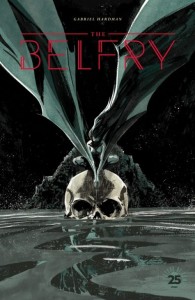 Lewis. However, he’s got a plastic, flexible style, reminiscent of Jim Mahfood but with more manga mixed in, and it creates a different look for each tale, including a woodcut-like black-and-white one originally conceived as a smartphone/digital comic, a short, sexy EC-like closer, and the two main stories, both leaning hard on the Heavy Metal/fantasy/videogame influences, but smart and good-looking and wildly kinetic, too; this is an impressive debut from a new talent, well worth risking your hard-earned $4.99. The Belfry is a stand-alone story entirely by Gabrial Hardman (Invisible Republic), about people who stumble onto a coven
Lewis. However, he’s got a plastic, flexible style, reminiscent of Jim Mahfood but with more manga mixed in, and it creates a different look for each tale, including a woodcut-like black-and-white one originally conceived as a smartphone/digital comic, a short, sexy EC-like closer, and the two main stories, both leaning hard on the Heavy Metal/fantasy/videogame influences, but smart and good-looking and wildly kinetic, too; this is an impressive debut from a new talent, well worth risking your hard-earned $4.99. The Belfry is a stand-alone story entirely by Gabrial Hardman (Invisible Republic), about people who stumble onto a coven  of vampires; he name-checks Gene Colan as an influence in the editorial, which gets him a free pass from me, and I like the off-balance, abrupt ending (a lot of creators would have drawn this out into a three- or four-issue mini-series, so props for knowing how to stop and leave readers wanting more). The Old Guard is the latest fantasy/sf series from Greg Rucka, about a group of four not-quite-immortals involved in modern military incursions; it has something of the offbeat violence and humanity of
of vampires; he name-checks Gene Colan as an influence in the editorial, which gets him a free pass from me, and I like the off-balance, abrupt ending (a lot of creators would have drawn this out into a three- or four-issue mini-series, so props for knowing how to stop and leave readers wanting more). The Old Guard is the latest fantasy/sf series from Greg Rucka, about a group of four not-quite-immortals involved in modern military incursions; it has something of the offbeat violence and humanity of  Lazarus, although it’s set in the present instead of the future, and artist Fernandez has a striking, heavily-inked style a lot like Eduardo Risso’s, so it’s a good-looking , noirish debut. The Visitor is actually a Hellboy comic, but the focus is on the title character, who arrives on Earth when the red-hued demon first shows up as a child, and follows him through the years, observing his actions and trying to decide whether to kill him as a threat, or spare him as a hero. The art’s by Paul Grist (Jack Staff, Kane), whose spare, fine-edged style turns out to mesh very well with Mignola’s to produce a cool, modern-looking book.
Lazarus, although it’s set in the present instead of the future, and artist Fernandez has a striking, heavily-inked style a lot like Eduardo Risso’s, so it’s a good-looking , noirish debut. The Visitor is actually a Hellboy comic, but the focus is on the title character, who arrives on Earth when the red-hued demon first shows up as a child, and follows him through the years, observing his actions and trying to decide whether to kill him as a threat, or spare him as a hero. The art’s by Paul Grist (Jack Staff, Kane), whose spare, fine-edged style turns out to mesh very well with Mignola’s to produce a cool, modern-looking book.
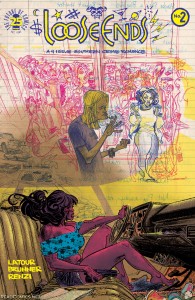 Loose Ends #2 (of 4) — Writer: Jason Latour; Art: Chris Brunner; Colors: Rico Renzi
Loose Ends #2 (of 4) — Writer: Jason Latour; Art: Chris Brunner; Colors: Rico Renzi
Astro City #41 — Writer: Kurt Busiek; Art: Brent E. Anderson; Colors: Peter Pantazis and Alex Sinclair
Jughead #13 — Writer: Ryan North; Art/Colors: Derek Charm
She-Wolf #6 — Creator: Rich Tommaso
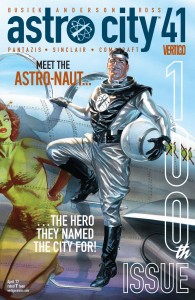 Stray Bullets: Sunshine and Roses #21 — Creator: David Lapham
Stray Bullets: Sunshine and Roses #21 — Creator: David Lapham
Rick and Morty #23 — Writer: Kyle Starks; Art: CJ Cannon; Colors: Katy Farina
If you like Southern Bastards, you’ll like Loose Ends: it’s by that book’s artist, and covers the same Southern-Gothic film-noir crime-and-corruption 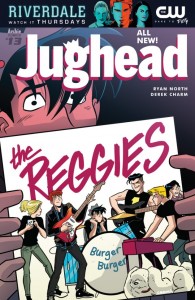 beat; the restless teens, football jocks and cold-eyed ne’er-do-wells of this town could move to SB‘s Craw County, Alabama and fit right in. Astro City celebrates its 100th issue with an origin story of sorts, looking at the 1940s Astro-Naut, a Buck Rogers-type pilot and space explorer who gave the city its name; it’s by Kurt Busiek and Brent Anderson, the book’s regular team for the 22 years it’s been around, and is just as well-written, action-
beat; the restless teens, football jocks and cold-eyed ne’er-do-wells of this town could move to SB‘s Craw County, Alabama and fit right in. Astro City celebrates its 100th issue with an origin story of sorts, looking at the 1940s Astro-Naut, a Buck Rogers-type pilot and space explorer who gave the city its name; it’s by Kurt Busiek and Brent Anderson, the book’s regular team for the 22 years it’s been around, and is just as well-written, action- filled and thought-provoking as ever. Jughead is in the middle of a three-parter about Reggie, having won a series of escalating videogame bets, gathering everyone as the musical group “The Reggies,” who are, natuarally, horrible, but then Jughead takes the video they made of themselves and gets techno-whiz Dilton to digitally replace everyone’s head with his (so: “The Jugheads”), and accidentally posts it online, after which, again naturally, it goes viral
filled and thought-provoking as ever. Jughead is in the middle of a three-parter about Reggie, having won a series of escalating videogame bets, gathering everyone as the musical group “The Reggies,” who are, natuarally, horrible, but then Jughead takes the video they made of themselves and gets techno-whiz Dilton to digitally replace everyone’s head with his (so: “The Jugheads”), and accidentally posts it online, after which, again naturally, it goes viral  and… well, it’s a lot of fun, with the North/Charm combo, which has now been on this book since issue #7, hitting just the right combination of humor, theme and high-energy insanity. Speaking of insanity, She-Wolf is an occult gonzo fever dream, combining lycanthropy, demonic possession, 7-Elevens, brightly-colored ultra-violence and some stunning art into a package that’s both disturbing and very pretty. That applies to Stray Bullets, too, although there’s nothing supernatural about that
and… well, it’s a lot of fun, with the North/Charm combo, which has now been on this book since issue #7, hitting just the right combination of humor, theme and high-energy insanity. Speaking of insanity, She-Wolf is an occult gonzo fever dream, combining lycanthropy, demonic possession, 7-Elevens, brightly-colored ultra-violence and some stunning art into a package that’s both disturbing and very pretty. That applies to Stray Bullets, too, although there’s nothing supernatural about that 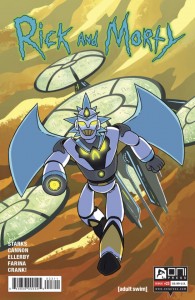 comic: just desperate, violent and sometimes sexy people doing desperate, violent and sometimes sexy things… and it’s great. Rick and Morty fits the same bill: when you have thousands of multiple-universe versions of your main characters running around, who cares if some (or most) of them die horribly? This issue concludes one such tale where Jerry, usually a loser, is replaced by an ultra-competent, multiverse-conquering doppleganger, leading to roughly equal amounts of hilarity and horrible death: standard procedure for this under-the-radar, oddly-compelling comic book.
comic: just desperate, violent and sometimes sexy people doing desperate, violent and sometimes sexy things… and it’s great. Rick and Morty fits the same bill: when you have thousands of multiple-universe versions of your main characters running around, who cares if some (or most) of them die horribly? This issue concludes one such tale where Jerry, usually a loser, is replaced by an ultra-competent, multiverse-conquering doppleganger, leading to roughly equal amounts of hilarity and horrible death: standard procedure for this under-the-radar, oddly-compelling comic book.


